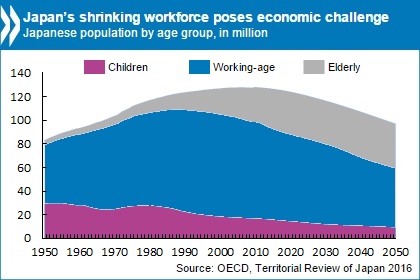 OECD press release, April 11: Japan must make revitalising growth its number one priority with reforms to boost productivity and encourage more women and older people into jobs to compensate for its rapidly shrinking labour force, according to the OECD. Japan’s population is set to shrink to 100 million by 2050 from a peak of 128 million in 2010. Life expectancy of 83.5 years is pushing up the old-age dependency ratio. Both trends are most severe in rural areas.
OECD press release, April 11: Japan must make revitalising growth its number one priority with reforms to boost productivity and encourage more women and older people into jobs to compensate for its rapidly shrinking labour force, according to the OECD. Japan’s population is set to shrink to 100 million by 2050 from a peak of 128 million in 2010. Life expectancy of 83.5 years is pushing up the old-age dependency ratio. Both trends are most severe in rural areas.
The OECD’s 2016 Territorial Review of Japan finds that demographic change knocked more than half a percentage point off Japan’s annual economic growth rate over 1999-2011. It warns of the pressure on public spending from rising pension, health and long-term care costs as the share of people over 65 in the population rises from 26% today to around 40% by 2050, the highest in the world.
Yet a declining population should allow more flexibility in land use, enabling cities to build more green spaces or community development projects as density eases, the Territorial Review says. It should reduce traffic congestion and ease pressure on housing prices and the environment. A larger elderly population could create demand for new goods and services and provide an experienced and flexible workforce for part-time jobs, entrepreneurship or volunteering.
In particular, the Review welcomes Japan’s 2015 National Spatial strategy as a step towards tackling the demographic transition. It suggests making cities more compact and improving links between them. The Review also recommends adapting policies in areas from city planning to employment to limit the impact of the rapid shrinking and ageing of the population. With the right policies, increased longevity among workers and less-dense towns and cities could bring opportunities for innovation, growth and well-being, the Review says.
Launching the Review in Tokyo on April 11, OECD Secretary General Angel Gurría said:
First, Japanese cities need to maximise agglomeration benefits. This could be done by combining infrastructure investments, such as the new super-high-speed maglev rail line linking Tokyo, Osaka and Nagoya into a single urban mega-region, with measures to promote entrepreneurship, innovation and venture capital investment.
Second, cities can benefit from better linkages between institutions and improved metropolitan governance. That means co-operating successfully across “thick” administrative borders. This is not just a matter of collaboration among public bodies: business-to-business connections, links between regional firms and nearby universities for example, are critical to knowledge creation, entrepreneurship and innovation. Governance at the metropolitan scale can also increase their productivity by co-ordinating policies, such as land-use, transport and economic development policies.
Read the OECD press release in full.
Many of the urban and rural challenges raised in the Review were discussed at our recent JLGC Seminar on ‘Better Ageing in Japan and UK City Regions’ by Setsuko Saya, Head of the Public Governance and Territorial Development Division at the OECD. Her presentation from the seminar is also available to view here.

